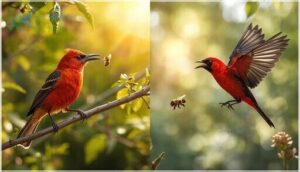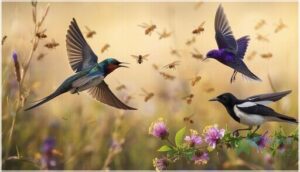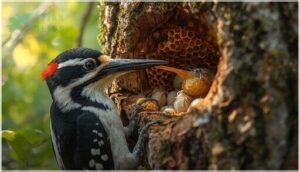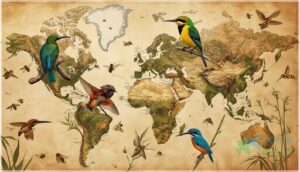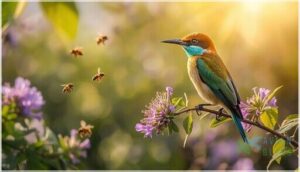This site is supported by our readers. We may earn a commission, at no cost to you, if you purchase through links.
A flash of color across your backyard, a sharp snap in midair, and suddenly a honeybee vanishes into the beak of a summer tanager. Yes, birds eat bees—and they’re remarkably good at it.
From specialized hunters like bee-eaters that feast on hundreds of stinging insects daily to opportunistic feeders like mockingbirds snatching the occasional bee from a flower, dozens of bird species have mastered the art of catching prey most animals avoid.
These aerial predators use clever tactics to disarm their targets, possess unique physical adaptations that protect them from stings, and play a surprisingly important role in keeping insect populations balanced.
Understanding which birds hunt bees, how they pull off these risky meals, and what it means for your garden’s ecosystem reveals a hidden interplay unfolding right above your head.
Table Of Contents
Key Takeaways
- Many bird species—from specialized bee-eaters that consume hundreds daily to opportunistic feeders like mockingbirds and tanagers—have evolved clever tactics and physical adaptations to safely hunt bees as protein-rich prey.
- Birds avoid stings through protective facial feathers, precise timing of attacks when bees are less active, and techniques like rubbing captured bees against branches to remove stingers before swallowing.
- While 50-100 bird species worldwide eat bees, their predation represents only a minor factor in bee population control compared to habitat loss, helping maintain ecosystem balance rather than threatening pollinator survival.
- Bee-eating birds provide natural pest control benefits in gardens and farms, reducing the need for chemical pesticides while participating in nutrient cycling and broader ecosystem regulation.
Do Birds Eat Bees?
Birds eat bees—it’s a natural part of the food web you might notice in your own backyard. Many insectivorous bird behavior patterns include targeting bees as a protein-rich food source, especially during peak foraging seasons. While bees play essential roles as pollinators, their abundance makes them available prey for various bird species that eat wasps and bees. Avian intelligence helps these hunters time their strikes precisely, avoiding most defensive responses.
The relationship between birds and bees reflects important ecosystem services where predation helps control insect populations. Though pollinator decline concerns many ecologists, bee predation by birds represents only a minor ecological factor compared to habitat loss. Birds don’t rely solely on bee nutrition—most species mix bees with other insects, adjusting their diet based on what’s available during bird migration and seasonal changes.
Understanding the importance of clear science writing is essential for effectively communicating the complex interactions between birds and bees.
Bird Species Known to Eat Bees
You might be surprised to learn that quite a few bird species include bees in their diet. Some birds are specialists that have evolved specifically to hunt bees, while others snack on them opportunistically alongside other insects.
Let’s look at the main bird groups known for their bee-eating habits.
Bee-eaters and Their Specialization
True specialists in the bird world, bee-eaters from the Meropidae family have perfected the art of catching bees mid-flight. You’ll find these brightly colored hunters mainly across Africa and Asia, where they’ve evolved exceptional adaptations:
- Extra feathers around their beaks shield them from potential stings during the hunt
- Slender, curved beaks act like precision tools for snatching flying insects
- Specialized hunting tactics allow them to disarm bees before swallowing them whole
These insectivorous bird adaptations showcase nature’s problem-solving at its finest. The study of such unique adaptations requires careful consideration of research methodology to fully understand their impact.
Summer and Scarlet Tanagers
While bee-eaters often steal the spotlight, Summer Tanagers and Scarlet Tanagers are quietly feasting on bees right here in North America. These insectivorous birds swiftly snatch bees mid-flight during their summer habitat foraging. Males of both species sport bold red plumage, making their behavior easy to spot. Their scarlet diet also includes bee larvae, which supports bird conservation efforts by naturally controlling pest populations.
| Feature | Summer Tanagers | Scarlet Tanagers |
|---|---|---|
| Body Type | Large with thick bills | Bold, striking appearance |
| Male Color | Bright red throughout | Vivid red with black wings |
| Female Color | Yellow-olive tones | Light yellow coloring |
| Tanager Migration | Southern U.S. to South America | Eastern forests to South America |
| Bee-Eating Frequency | High during insect-rearing | Opportunistic when prey scarce |
Swallows, Purple Martins, and Magpies
You’ll also find swallows, Purple Martins, and magpies among insectivorous birds that hunt bees through distinct feeding strategies. Swallows and Purple Martins excel at aerial foraging, swooping down to catch bees mid-flight near their nesting habits in North America. Magpies, meanwhile, forage closer to the ground around flowers and low branches.
During bird migration seasons, these birds that eat bees help naturally regulate populations without overwhelming colony defense mechanisms.
Mockingbirds, Cardinals, and Honeyeaters
Among your backyard visitors, mockingbirds ramp up their insect intake during summer months, opportunistically snatching bees alongside other prey. Cardinals forage beneath leaves and around flowers, where they’ll catch bees when they’re available. Honeyeaters balance their diet between flower nectar and insects like bees and wasps.
These insectivorous birds adjust their feeding habits seasonally, incorporating bees as protein-rich additions without specialized hunting strategies.
Woodpeckers and Bee Larvae Predation
When woodpeckers explore tree cavities, they’ll extract bee larvae from accessible nest chambers using their specialized long tongues. This nest predation usually targets exposed brood cells rather than active hives.
Woodpeckers view bee larvae as a secondary food source during cavity exploration, and this insectivorous behavior can influence local colony dynamics in forest ecosystems, though it remains opportunistic rather than a primary feeding strategy affecting ecosystem balance.
How Birds Catch and Eat Bees
Watching a bird snatch a bee out of midair might seem risky, but these birds have turned bee-hunting into an art form. They use specialized techniques and physical adaptations that keep them safe while securing a protein-rich meal.
Let’s look at how different species catch bees, what makes their bodies suited for the job, and how they avoid getting stung.
Hunting Techniques and Strategies
Birds eat bees using a variety of clever foraging strategies that reduce their risk of getting stung. You’ll notice bee-eating birds employ aerial pursuits, flight tactics, and nest raiding to secure protein-rich meals. These insectivorous birds showcase fascinating bird behavior and ecology through their hunting methods:
- High-altitude swoops surprise bee colonies during a bee ambush
- Visual stalking from perches intercepts foragers near flowers
- Ground-foraging birds probe tree bark for bee larvae
- Stealth approaches during cooler periods increase capture success
Physical Adaptations for Bee Predation
When you watch bee-eating birds in action, you’ll notice specialized equipment that makes their diet possible. Beak structure varies from curved bills in bee-eaters to stout beaks perfect for pinching insects mid-flight.
Feather protection around facial areas deflects bee stingers, while tongue morphology helps these insectivorous birds grasp prey safely. Flight agility and plumage camouflage complete their hunting toolkit.
How Birds Avoid Bee Stings
Getting stung rarely happens because birds eat bees using smart sting avoidance tactics. Your backyard insectivorous birds time their foraging strategies when bees are less active, while feather protection around their beaks blocks bee stingers.
These hunting tactics include quick strikes and targeting less-defended hive areas. Bird behavior shows they’ll switch prey types entirely if bee defense becomes too aggressive, proving nature rewards flexibility.
Geographic Distribution of Bee-Eating Birds
You’ll find bee-eating birds on nearly every continent, though they’re not spread out evenly across the globe. Some regions have specialist bee-eaters that focus almost exclusively on bees, while others are home to opportunistic species that snatch bees when the chance arises.
Let’s look at where these birds live and how their bee-eating habits change from place to place.
Regional Variations in Bee-Eating Behavior
Where you live shapes which birds eat bees in your area. Migration patterns create seasonal shifts in bee-eating activity—European Bee-eaters hunt heavily during summer breeding, then fly to Africa.
Latitudinal gradients matter too: tropical regions support year-round insectivorous bird species, while temperate zones see brief, intense predation windows.
Habitat context and urban effects further influence regional bee-eating behavior in avian ecology and conservation studies.
Common Backyard Bee-Eating Birds
Your own backyard might host several bee-eating birds without you realizing it. Northern Mockingbirds and Carolina Chickadees snatch bees from flowers and swarms, especially when feeding their young. Purple Martins grab bees mid-flight during breeding season. European Starlings occasionally raid exposed hives.
These species balance backyard bird feeding with local pollinator support, creating complex garden bird diversity you can observe daily.
Bee-Eating Specialists Around The World
Across Africa and Asia, bee-eaters (Merops spp.) reign as the world’s most specialized bee predators, with twenty-two species targeting flying insects along forest edges and savannas. These insectivores showcase striking avian bee interactions through aerial hawking and synchronized foraging.
European species migrate seasonally, while American tanagers demonstrate diverse bee-eating bird species behavior.
This global bee distribution shapes ecosystem pollination dynamics and highlights exceptional bee predator diversity in insectivory worldwide.
Ecological Impact of Birds Eating Bees
Birds eating bees might seem like bad news for pollinators, but the relationship is more complicated than you’d think. These hunting behaviors actually play a small but real role in keeping ecosystems balanced.
Let’s look at how bee-eating birds affect nature and help control pests, and what it means for bee populations overall.
Role in Ecosystem Balance
Balance defines healthy ecosystems, and bee-eating birds play their part in maintaining it. When birds hunt bees and other insects, they contribute to wildlife conservation through several pathways:
Birds eating bees contribute to wildlife conservation by naturally regulating insect populations and maintaining ecosystem balance
- Ecosystem regulation – Birds control insect populations naturally, preventing any one species from dominating
- Pollination effects – By influencing which insects thrive, they shape flowering plant communities
- Nutrient cycling – Their feeding habits redistribute nutrients across habitats, supporting biodiversity conservation
This avian ecology creates ecological balance you can observe in your own backyard.
Birds as Natural Pest Control
Birds eat bees as part of broader pest management strategies that benefit you and your garden. These ecosystem services reduce crop damage in orchards and farms, lowering your need for chemical pesticides.
Bird conservation enhances pollinator health indirectly—when birds control pest insects, biodiversity benefits flow throughout the system. You’ll notice fewer harmful pests where avian ecology thrives, supporting wildlife conservation efforts naturally.
Consequences for Bee Populations
Predation pressure from bee-eating birds contributes to bee colony stress and pollination decline in your local ecosystems. While birds eat bees as part of natural insect ecology, studies show specialized bee-eating birds can reduce foraging success during peak seasons, potentially triggering ecosystem disruption.
These food chain impacts vary by habitat—fragmented environments face stronger biodiversity loss, though other pollinators often maintain ecosystem balance.
Frequently Asked Questions (FAQs)
What birds eat bees?
You’ll spot bee-eaters dominating this niche, but purple martins, swallows, tanagers, woodpeckers, and mockingbirds also feast on bees.
These insectivorous birds showcase impressive foraging behaviors and avian diet diversity across continents.
Who should not consume beets?
If you have a beet allergy, oxalate kidney stones, diabetes management needs, or take anticoagulant medications, you’ll want to avoid or limit beets—much like how birds eat bees selectively based on specialized adaptations.
Why do birds eat bees?
Like a Victorian naturalist observing feeding patterns, you’ll notice birds eat bees for high-quality insect protein rich in essential amino acids.
This foraging strategy provides quick energy, supporting avian diet requirements through adaptive behaviors around bee-rich flowering plants.
How many species of birds eat bees?
You’ll find 50 to 100 bird species worldwide that prey on bees, showcasing impressive bee predator diversity.
This global bee consumption includes specialized bee-eating birds and opportunistic avian insectivores with varied bee eating habits.
Do birds eat dead bees?
You might notice a chickadee hopping near your garden hive, pecking at fallen workers.
Yes, birds scavenge dead bees opportunistically—these protein-rich carcasses become easy meals when other insects are scarce, supporting avian foraging strategies.
Do birds eat wood bees?
Yes, birds eat bees, including wood bees. Woodpeckers extract bee larvae from nesting sites in decaying wood, while insectivorous bird species catch adult wood bees mid-flight during foraging patrols through woodland ecosystems.
What is the main predator of a bee?
Predator-prey dynamics shift like shadows across continents. Bee-eaters, honeyguides, and wasps dominate as primary bee predators, while hornets and specialized insectivory birds opportunistically hunt them.
This ecosystem balance varies regionally across Africa, Asia, and Europe.
Do birds get rid of bees?
Birds don’t eliminate bee populations but control them naturally. Bee-eating birds help maintain ecosystem balance by targeting accessible individuals, though their impact on pollinator decline remains minimal compared to habitat loss and pesticides.
What happens if a bird eats a bee?
When a bird eats a bee, it gains protein-rich nutrition through rapid digestion.
Birds remove stingers by rubbing bees against branches, avoiding toxicity effects. Their immune response and protective feathers prevent serious injury from bee-eating behavior.
How do birds eat bees without getting stung?
Like a boxer weaving between punches, bee-eating birds use aerial maneuvers and lightning-fast strikes to grab their prey mid-flight.
Their specialized beaks and feeding strategies minimize contact, preventing stings before bees can react.
Conclusion
That honeybee disappearing into a tanager’s beak isn’t just a meal—it’s a thread in nature’s carefully woven safety net. Whether it’s a bee-eater dismantling hundreds daily or a cardinal snatching one opportunistically, these aerial hunters remind you that every backyard harbors hidden choreography where predator and prey maintain the balance life depends on.
Now you understand how birds eat bees through specialized tactics, physical defenses, and ecological roles that keep insect populations stable.
- https://www.theguardian.com/environment/2025/jan/18/country-diary-why-does-the-bird-bob-its-head
- https://www.wikihow.com/Bird-Symbolism
- https://apnews.com/article/composting-pumpkins-halloween-jack-o-lanterns-gardening-921757fbb2bf84d9e5c55f55a63b280a
- https://animals.sandiegozoo.org/animals/bee-eater
- https://profile.google.com/cp/Cg0vZy8xMXRqcnoydzMx



